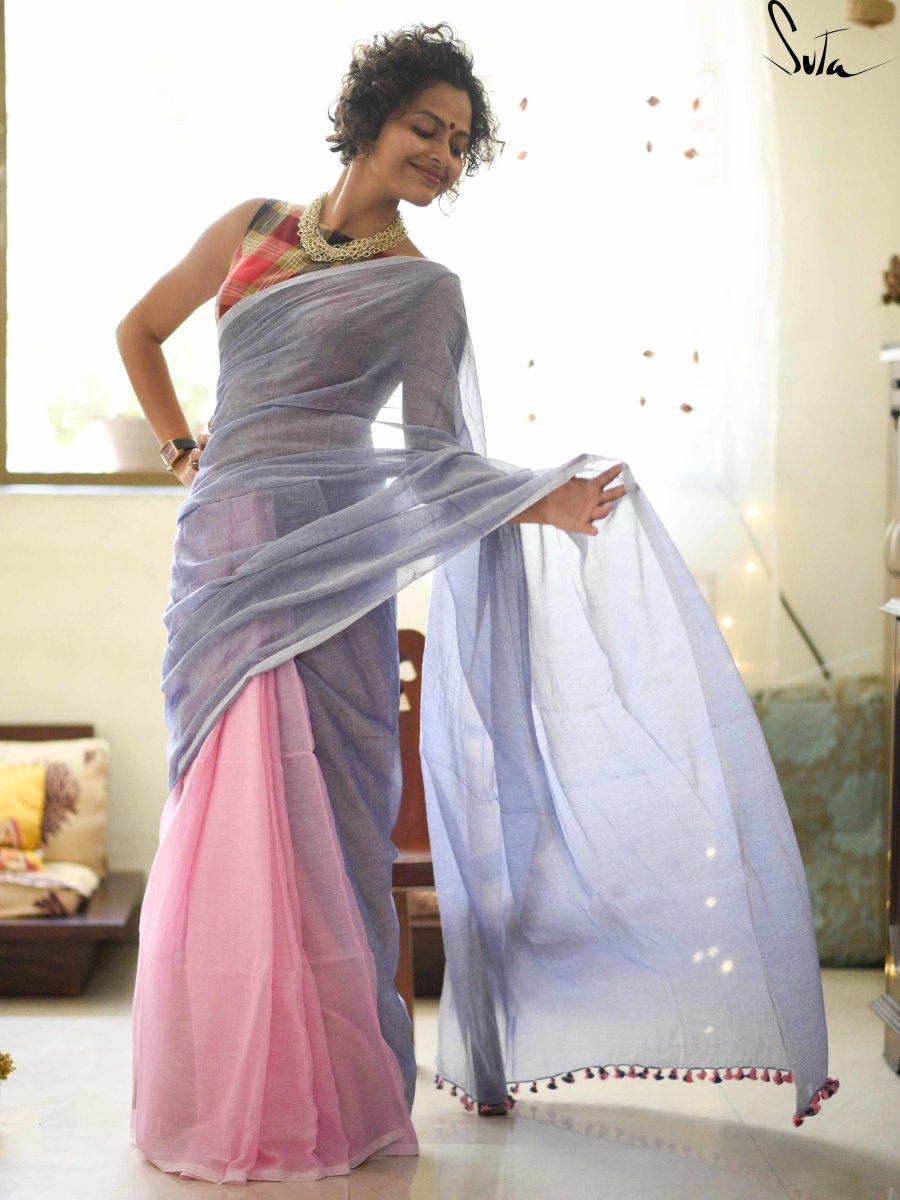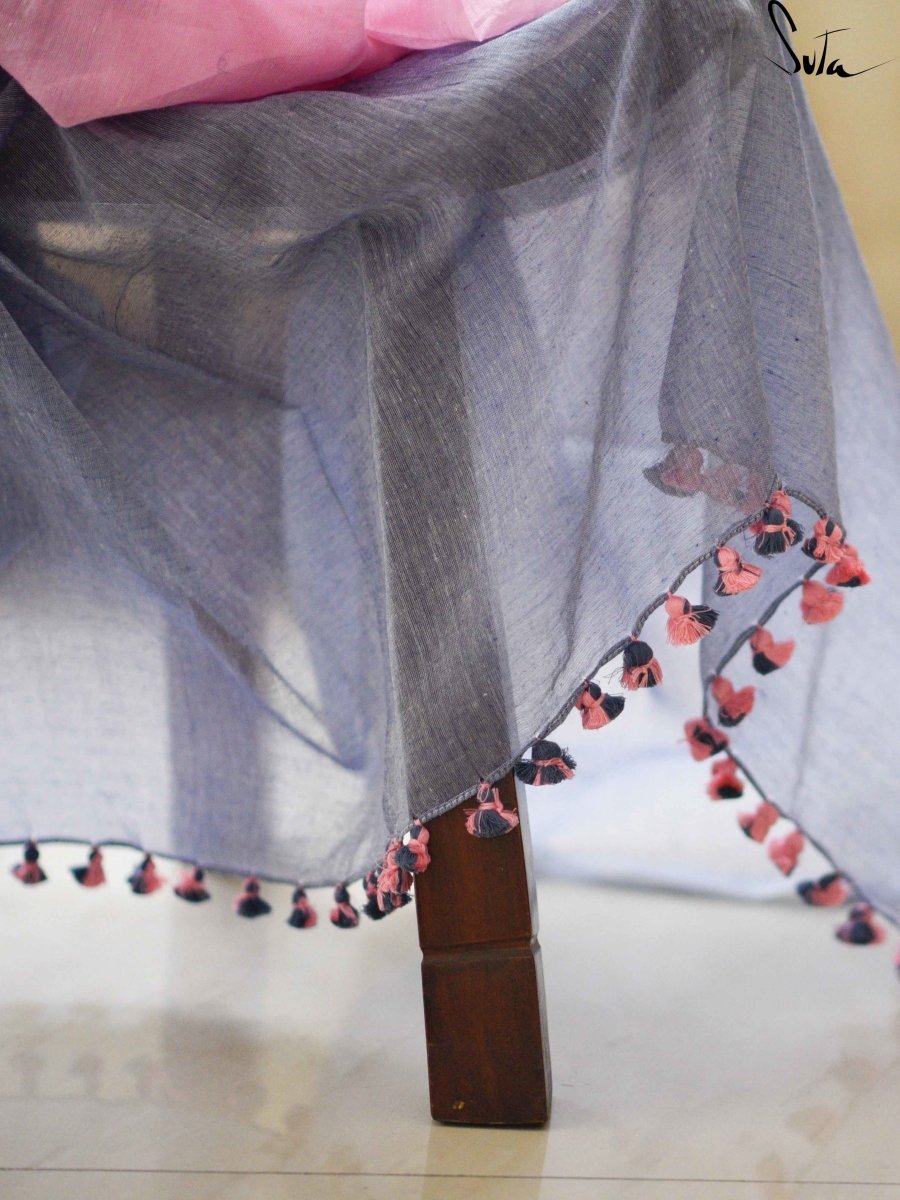







Rose In Midnight (Saree)
Kindly empty your cart to purchase a Suta product OR checkout with the existing Relove products of your cart and then, shop Suta products.
SB3G10
Buy 3 & Get FLAT 10% OFF
SB5G15
Buy 5 & Get FLAT 15% OFF
SB10G20
Buy 10 & Get FLAT 20% OFF
Free shipping on domestic orders above Rs. 1,950
Hassle-free 10 days return & exchange
Cash on delivery is available
- Details
- Story
- Description
Product Type: Saree
Length: 5.50 m (550.00 cm) ; Width: 1.19 m (119.38 cm)
Blouse Piece: No
Wash Care: Dry Wash
Blouse: Su, the model is wearing a blouse called Red Checkered
Disclaimer: The pictures are clicked in daylight. Color may vary slightly from the image due to the screen brightness.
What You will Recieve: 1 Saree
This parcel of love in pastel shades. Once draped wont let your heart leave this saree. A perfect office wear to stay sexy yet summery. A must must have!
The mul cotton is what we call Made in Heaven at Suta. Known in West Bengal as mul mul, the fabric is what can be categorised as muslin cotton. It is believed that this fine method of weaving cotton can be traced back to even before the Indus valley civilization. What makes this fabric special is the almost magical process of weaving it. Cotton fibres are separated and spun into strong threads. The lightest and the most delicate fibres are separated and are then spun into muslin thread. These are then woven into fabrics by skilled weavers. The history of muslin weaving is a beautiful chapter in the history of Indian textiles. The process of the yore was much more complex and involved many unique tools that look primitive but worked like magic. The upper jaw of a catfish was used to initially clean the cotton before spinning. To separate the lightest fibres, a Dhunkar (a bamboo bow) was used, which when strung in a distinctive way made the lighter fibres rise above the heavier ones. This process gave the title Woven Air to the muslin fabric. Weavers famously wove on looms that were at ground level and operated the looms from pits dug in the ground. Even during the Mughal era, the muslin fabric was seen as a symbol of power for its finesse. History is full of anecdotes to prove the awe that the muslin fabric generated. Emperor Aurangzeb is said to have chided his daughter Zeb-un-Nisa for appearing naked in the court when in reality she had been wearing several layers of the muslin cloth! Such was the fabrics delicateness. The almost invisible fabric had made an Arab traveller in the 10th century remark that the degree of fineness is such that a garment can be drawn through a ring of a middling size. During the British colonisation and even during the Mughal rule, the art of weaving muslin took a hit as weavers were treated poorly and drought hit many of the weaving centres. As a result, today, the process of weaving has seen a lot of change. Nevertheless, the essence of it hasn't changed and the charm of the fabric still remains.
Product Type: Saree
Length: 5.50 m (550.00 cm) ; Width: 1.19 m (119.38 cm)
Blouse Piece: No
Wash Care: Dry Wash
Blouse: Su, the model is wearing a blouse called Red Checkered
Disclaimer: The pictures are clicked in daylight. Color may vary slightly from the image due to the screen brightness.
SKU: SUTAMIH010
What You will Receive: 1 Saree
This parcel of love in pastel shades. Once draped wont let your heart leave this saree. A perfect office wear to stay sexy yet summery. A must must have!
The mul cotton is what we call Made in Heaven at Suta. Known in West Bengal as mul mul, the fabric is what can be categorised as muslin cotton. It is believed that this fine method of weaving cotton can be traced back to even before the Indus valley civilization. What makes this fabric special is the almost magical process of weaving it. Cotton fibres are separated and spun into strong threads. The lightest and the most delicate fibres are separated and are then spun into muslin thread. These are then woven into fabrics by skilled weavers. The history of muslin weaving is a beautiful chapter in the history of Indian textiles. The process of the yore was much more complex and involved many unique tools that look primitive but worked like magic. The upper jaw of a catfish was used to initially clean the cotton before spinning. To separate the lightest fibres, a Dhunkar (a bamboo bow) was used, which when strung in a distinctive way made the lighter fibres rise above the heavier ones. This process gave the title Woven Air to the muslin fabric. Weavers famously wove on looms that were at ground level and operated the looms from pits dug in the ground. Even during the Mughal era, the muslin fabric was seen as a symbol of power for its finesse. History is full of anecdotes to prove the awe that the muslin fabric generated. Emperor Aurangzeb is said to have chided his daughter Zeb-un-Nisa for appearing naked in the court when in reality she had been wearing several layers of the muslin cloth! Such was the fabrics delicateness. The almost invisible fabric had made an Arab traveller in the 10th century remark that the degree of fineness is such that a garment can be drawn through a ring of a middling size. During the British colonisation and even during the Mughal rule, the art of weaving muslin took a hit as weavers were treated poorly and drought hit many of the weaving centres. As a result, today, the process of weaving has seen a lot of change. Nevertheless, the essence of it hasn't changed and the charm of the fabric still remains.
We offer a hassle-free 10 days returns and exchange for products bought at MRP. Only exchange requests will be accepted for products bought during sales or at discounted prices. However on using coupon codes SB3G10, SB5G15 or SB10G20, only size variant exchange will be applicable.
- Refunds for prepaid orders will directly be initiated to the source account. For COD orders, you will receive a Cashgram link via SMS/email, which you can use to redeem the refund.
- Complaints regarding defective or incorrect products, and incomplete orders issue should be raised with us within 48 hours of receiving the products. Please do share the image or video highlighting your concern. For all such queries, please write to us at returns@suta.in
- If you wish to exchange a product, a store credit/credit note will be issued, which you can use to place a fresh order online. Please note that credit note/store credit cannot be encashed, and cannot be used for offline purchases.
Country of Origin: India
Packed By: Suta Pvt. Ltd.
Registered Address: Om ShivAmbika Co-Op Hsg Soc, Kalina, Santacruz East, Mumbai-400098
Choose options














